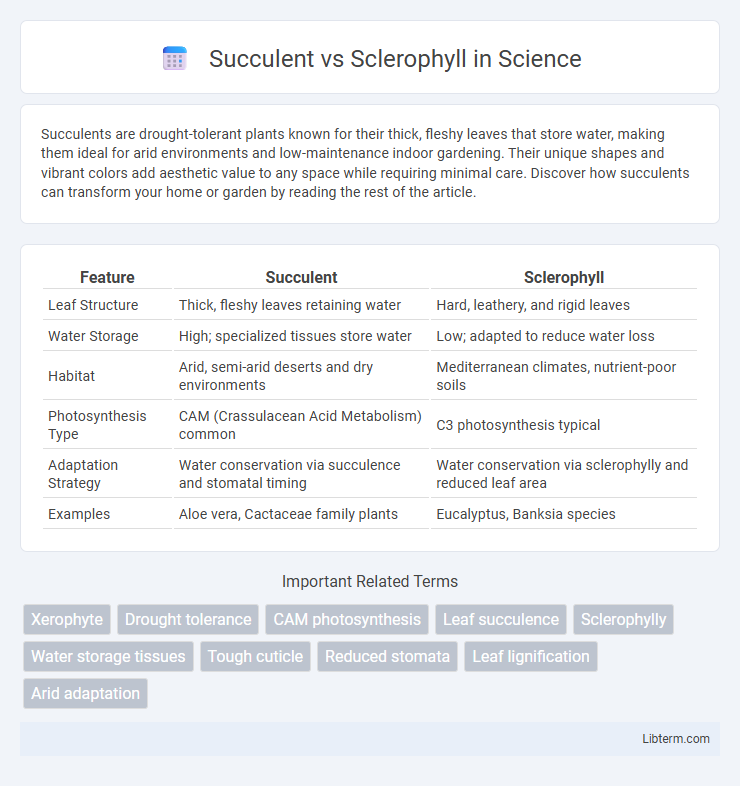Succulents are drought-tolerant plants known for their thick, fleshy leaves that store water, making them ideal for arid environments and low-maintenance indoor gardening. Their unique shapes and vibrant colors add aesthetic value to any space while requiring minimal care. Discover how succulents can transform your home or garden by reading the rest of the article.
Table of Comparison
| Feature | Succulent | Sclerophyll |
|---|---|---|
| Leaf Structure | Thick, fleshy leaves retaining water | Hard, leathery, and rigid leaves |
| Water Storage | High; specialized tissues store water | Low; adapted to reduce water loss |
| Habitat | Arid, semi-arid deserts and dry environments | Mediterranean climates, nutrient-poor soils |
| Photosynthesis Type | CAM (Crassulacean Acid Metabolism) common | C3 photosynthesis typical |
| Adaptation Strategy | Water conservation via succulence and stomatal timing | Water conservation via sclerophylly and reduced leaf area |
| Examples | Aloe vera, Cactaceae family plants | Eucalyptus, Banksia species |
Introduction to Succulents and Sclerophylls
Succulents are plants adapted to arid environments, characterized by thick, fleshy tissues that store water, enabling survival through prolonged droughts. Sclerophylls possess hard, leathery leaves with a high concentration of lignin and cellulose, designed to minimize water loss and withstand nutrient-poor soils, commonly found in Mediterranean and Australian ecosystems. Both plant types exhibit specialized adaptations for water conservation, but succulents rely on internal water storage, whereas sclerophylls optimize leaf structure and chemical defenses.
Defining Succulent Plants
Succulent plants are characterized by their thick, fleshy tissues adapted for water storage, allowing them to thrive in arid environments with minimal moisture. These adaptations distinguish succulents from sclerophyll plants, which possess hard, tough leaves designed to reduce water loss but do not store water in specialized tissues. Examples of succulents include cacti, aloe, and agave, whose structural modifications enable efficient water retention in drought-prone habitats.
Understanding Sclerophyllous Plants
Sclerophyllous plants possess tough, leathery leaves with thick cuticles that minimize water loss, enabling them to thrive in arid and nutrient-poor environments. These adaptations include dense cell structures and reduced stomatal openings, which contrast with the fleshy, water-storing tissues characteristic of succulents. Understanding the physiological and structural traits of sclerophylls clarifies their ecological role in Mediterranean climates and other dry habitats.
Key Morphological Differences
Succulents possess thick, fleshy leaves or stems adapted for water storage, featuring minimal surface area to reduce water loss. Sclerophyll plants have hard, leathery leaves with a dense, fibrous texture and a thick cuticle, designed to minimize transpiration in nutrient-poor environments. The primary morphological distinction lies in succulents' specialized water-retentive structures versus sclerophylls' tough, drought-resistant foliage.
Adaptations to Environmental Conditions
Succulents adapt to arid environments by storing water in their thick, fleshy leaves or stems, enabling survival during prolonged droughts. Sclerophyll plants possess hard, leathery leaves with a thick cuticle and sunken stomata to reduce water loss and withstand nutrient-poor, dry soils. Both plant types exhibit specialized adaptations that optimize water conservation and resilience in their respective harsh habitats.
Water Storage Mechanisms
Succulents store water in specialized fleshy tissues such as leaves, stems, or roots, enabling them to survive prolonged droughts by retaining large water reserves. Sclerophyll plants possess tough, leathery leaves with thick cuticles and sunken stomata, reducing water loss through transpiration rather than extensive water storage. These distinct water storage and conservation strategies reflect adaptations to arid environments where water availability limits plant growth.
Leaf Structure and Texture Comparison
Succulent leaves are thick, fleshy, and water-storing, adapted to arid environments by retaining moisture within specialized parenchyma cells. Sclerophyll leaves are hard, leathery, and densely packed with cellulose and lignin, designed to reduce water loss and withstand nutrient-poor, dry soils. The texture of succulents is typically smooth and swollen, while sclerophyll leaves exhibit a tough, rigid surface with a waxy cuticle for enhanced protection.
Geographic Distribution and Habitats
Succulent plants are predominantly found in arid and semi-arid regions such as deserts in North America, Africa, and parts of Australia, where they thrive by storing water in their thick, fleshy tissues. Sclerophyll vegetation primarily occurs in Mediterranean climates, including parts of Australia, South Africa, California, and the Mediterranean Basin, characterized by nutrient-poor soils and seasonal droughts with hard, leathery leaves adapted to conserve moisture. Both plant types demonstrate specialized adaptations to their respective habitats, with succulents excelling in extreme water scarcity and sclerophylls in nutrient-poor, dry environments.
Ecological Roles and Functions
Succulents play a crucial ecological role in arid environments by storing water in fleshy tissues, enabling them to survive prolonged droughts and provide habitats for specialized fauna. Sclerophyll plants, characterized by hard, leathery leaves with high lignin content, dominate Mediterranean-type ecosystems and contribute to soil stability, fire resistance, and nutrient cycling. Both plant types support biodiversity by adapting to specific climatic stresses and influencing community structure through their unique physiological traits.
Succulents vs Sclerophylls: Which to Choose for Your Garden?
Succulents, known for their water-storing thick leaves, thrive in arid environments and require minimal watering, making them ideal for drought-prone gardens. Sclerophylls, characterized by tough, leathery leaves, adapt well to nutrient-poor soils and tolerate heat and dry conditions, common in Mediterranean climates. Choosing between succulents and sclerophylls depends on your garden's water availability, soil type, and climate resilience needs.
Succulent Infographic

 libterm.com
libterm.com